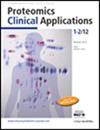Proteomic and metabolomic characterization of bone, liver, and lung metastases in plasma of breast cancer patients
IF 2.5
4区 生物学
Q3 BIOCHEMICAL RESEARCH METHODS
引用次数: 0
Abstract
BackgroundBreast cancer (BC) is the second leading cause of cancer‐related deaths among women, primarily due to metastases to other organs rather than the primary tumor.MethodsIn this study, a comprehensive analysis of plasma proteomics and metabolomics was conducted on a cohort of 51 BC patients. Potential biomarkers were screened by the Least Absolute Shrinkage and Selection Operator (LASSO) regression and Random Forest algorithm. Additionally, enzyme‐linked immunosorbent assay (ELISA) kits and untargeted metabolomics were utilized to validate the prognostic biomarkers in an independent cohort.ResultsIn the study, extracellular matrix (ECM)‐related functional enrichments were observed to be enriched in BC cases with bone metastases. Proteins dysregulated in retinol metabolism in liver metastases and leukocyte transendothelial migration in lung metastases were also identified. Machine learning models identified specific biomarker panels for each metastasis type, achieving high diagnostic accuracy with area under the curve (AUC) of 0.955 for bone, 0.941 for liver, and 0.989 for lung metastases.ConclusionsFor bone metastasis, biomarkers such as leucyl‐tryptophan, LysoPC(P‐16:0/0:0), FN1, and HSPG2 have been validated. dUDP, LPE(18:1/0:0), and aspartylphenylalanine have been confirmed for liver metastasis. For lung metastasis, dUDP, testosterone sulfate, and PE(14:0/20:5) have been established.乳腺癌患者血浆中骨、肝和肺转移的蛋白质组和代谢组特征
背景乳腺癌(BC)是女性癌症相关死亡的第二大原因,主要是由于转移到其他器官而不是原发肿瘤。方法本研究对 51 例 BC 患者进行了血浆蛋白质组学和代谢组学的综合分析。采用最小绝对缩减和选择操作器(LASSO)回归和随机森林算法筛选潜在的生物标志物。此外,还利用酶联免疫吸附试验(ELISA)试剂盒和非靶向代谢组学在一个独立队列中验证了预后生物标志物。此外,还发现了肝转移瘤中视黄醇代谢失调的蛋白质和肺转移瘤中白细胞跨内皮迁移的蛋白质。机器学习模型为每种转移类型确定了特定的生物标记物面板,诊断准确率很高,骨转移的曲线下面积(AUC)为 0.955,肝转移的曲线下面积(AUC)为 0.941,肺转移的曲线下面积(AUC)为 0.989。结论对于骨转移,亮氨酰色氨酸、LysoPC(P-16:0/0:0)、FN1 和 HSPG2 等生物标志物已经得到验证。对于肺转移,dUDP、硫酸睾酮和 PE(14:0/20:5)已被证实。
本文章由计算机程序翻译,如有差异,请以英文原文为准。
求助全文
约1分钟内获得全文
求助全文
来源期刊

PROTEOMICS – Clinical Applications
医学-生化研究方法
CiteScore
5.20
自引率
5.00%
发文量
50
审稿时长
1 months
期刊介绍:
PROTEOMICS - Clinical Applications has developed into a key source of information in the field of applying proteomics to the study of human disease and translation to the clinic. With 12 issues per year, the journal will publish papers in all relevant areas including:
-basic proteomic research designed to further understand the molecular mechanisms underlying dysfunction in human disease
-the results of proteomic studies dedicated to the discovery and validation of diagnostic and prognostic disease biomarkers
-the use of proteomics for the discovery of novel drug targets
-the application of proteomics in the drug development pipeline
-the use of proteomics as a component of clinical trials.
 求助内容:
求助内容: 应助结果提醒方式:
应助结果提醒方式:


